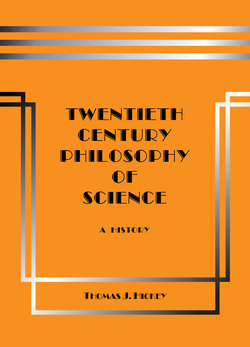Читать книгу Twentieth-Century Philosophy of Science: A History (Third Edition) - Thomas J. Hickey - Страница 101
На сайте Литреса книга снята с продажи.
4.21 Scientific Truth
ОглавлениеTruth and falsehood are properties of statements, and admit to more or less.
Tested and nonfalsified statements are more empirically adequate, have more realistic ontologies, and have more truth than falsified ones.
Falsified statements have recognized error, and may simply be rejected unless they are still useful for their lesser realism and lesser truth.
What is truth! Truth is a property of descriptive language with its relativized semantics and ontology. It is not merely a subjective expression of approval.
Belief and truth are not identical. Belief is acceptance of a statement as true. But one may wrongly believe that a false statement is true, or wrongly believe that a true statement is false. Belief controls the semantics of the descriptive terms in universally quantified statements. Truth is the relation of a statement’s semantics to nonlinguistic reality. Furthermore as Jarrett Leplin maintains in his Defense of Scientific Realism, truth and falsehood are properties of statements that admit to more or less; they are not simply dichotomous, as they are represented in two-valued formal logic.
Test-design language is presumed true with definitional force for the semantics of the test-design language, in order to identify the subject of the test. Theory language in an empirical test may be believed true by the developer and advocates of the theory, but the theory is not true simply by virtue of their belief. Belief in an untested theory is speculation about a future test outcome. A nonfalsifying test outcome will warrant belief that the tested theory is as true as the theory’s demonstrated empirical adequacy. Empirically falsified theories have recognized error, and may be rejected unless they are still useful for their lesser realism and lesser truth. Tested and nonfalsified statements are more empirically adequate, have ontologies that are more realistic, and thus are truer than empirically falsified statements.
Popper said that Eddington’s historic eclipse test of Einstein’s theory of gravitation in 1919 “falsified” Newton’s theory and thus “corroborated” Einstein’s theory. Yet the U.S. National Aeronautics and Space Administration (NASA) today uses Newton’s laws to navigate interplanetary rocket flights such as the Voyager missions. Thus Newton’s “falsified” theory is not completely false or it could never have been used before or after Einstein. Popper said that science does not attain truth. But contemporary pragmatists believe that such an absolutist idea of truth is misconceived. Advancement in empirical adequacy is advancement in realism and in truth. Feyerabend said, “Anything goes”. Regarding ontology Hickey says, “Everything goes”, because while not all discourses are equally valid, there is no semantics utterly devoid of ontological significance. Therefore he adds that the more empirically adequate tested theory goes farther – is truer and more realistic – than its less empirically adequate falsified alternatives. As science grows in empirical adequacy, it thereby progresses in truth and in realism.
